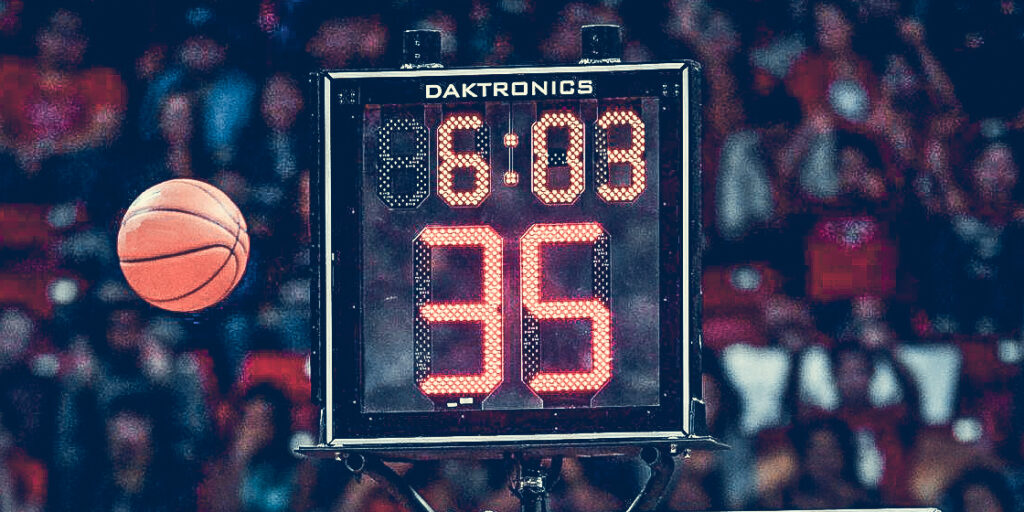By Nathaniel Ford
On January 3, 2020, Manchester West was facing Souhegan in Division II play. West led 26-23 going into the second half, and Souhegan came out in a zone defense. What happened next put on full display why a shot clock is necessary in the state.
West held the ball at half court, and Souhegan did not pressure them. In the entire third quarter, one shot was taken. For eight full minutes of play, only a single field goal was attempted.
This is not the first time this has happened, and if no shot clock is added, it probably will not be the last. This strategy really takes away from the essence of high school basketball. Holding the ball is not fun for the players or fans, and it diminishes the competition that every game provides.
This is far from the only reason a shot clock could be beneficial for the sport. In total, 27 states have approved a 30 or 35 second shot clock, including our neighbor Massachusetts. Multiple NHIAA athletes have voiced that the lack of a shot clock can be detrimental in their recruitment from collegiate programs.
The NCAA has a 30 second shot clock across the country. Transitioning from the high school game to college is a big jump already. The speed, physicality, and competition is all increased even more at the college level. Needing to adjust to a shot clock as well can just add to that tough transition.
Across the state, there is a lot of support from many people involved in the basketball community. Players, coaches, officials, and fans are all in support of a shot clock, and this is definitely the majority.
“I was hoping I would see it before I retired. I think it would add to the game,” said Coe-Brown head coach David Smith. He is a legend and very respected in the NH basketball scene.
“I think it would be a lot of fun to coach with a shot clock, and it would increase the importance of having quick hitters to get looks late in possessions,” said Profile coach Mitchell Roy. He had experience working with the Endicott College basketball team, so he’s worked with a shot clock.
One reason some have against the implementation of the clock is that it would require coaches to adjust their strategies and would be a very difficult change. However, it is evident that many coaches would love to see it added in the state, as it can provide some creativity with strategy.
“At the end of the game, it would make a difference if you have a slight lead and still need to get a shot up,” said Smith.
This clock would force teams to continue running an offense and attacking the hoop, which would lead to more exciting finishes to games.
Another benefit of a shot clock is that it could increase defensive intensity across the board. “It gives teams a better opportunity to play defense, whether it is for 30 or 35 seconds,” said Smith.
Overall, there are a ton of positives for a shot clock, which is why there are calls for its addition. However, the voices on the other side of the argument have some valid points as well.
The most obvious concern is the price and the installation of the clocks. Every school would need to buy two, one for each basket, and then wire them to the scorer’s table. While this would be a large upfront payment, there is possibly a larger concern.
“The biggest thing would be finding someone to operate the shot clock. You’d have to find another person willing to do the clock, and they would be paid the same as the game clock operator,” said Coe-Brown athletic director Samuel Struthers.
Operating a shot clock takes training and full attention into the game. The operator must understand all of the instances where it needs to be reset, which can be pretty fast-paced at times in a game.
“We have a hard time finding someone to operate the clock at a smaller school. Now to make sure everyone gets training on the shot clock rules? It’s easier said than done,” said Roy.
Schools across the state already struggle to get an operator for the main scoreboard, and this person would not be able to do the shot clock as well. Finding a second person could prove to be a near impossible task.
Regardless, the nationwide trend is towards a shot clock, and at some point, New Hampshire will have to get on board. The benefits to adding a shot clock definitely outweigh the concerns.
It seems inevitable that New Hampshire will bring it to the state. It could be within a couple of years, or it could be far down the line, but if a shot clock is on the horizon, the earlier it is implemented, the better.


